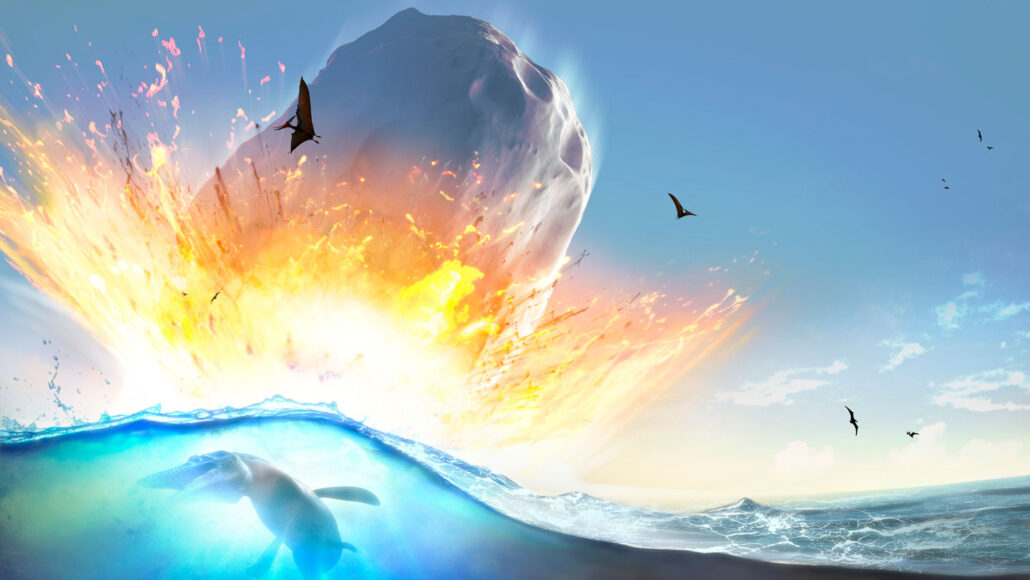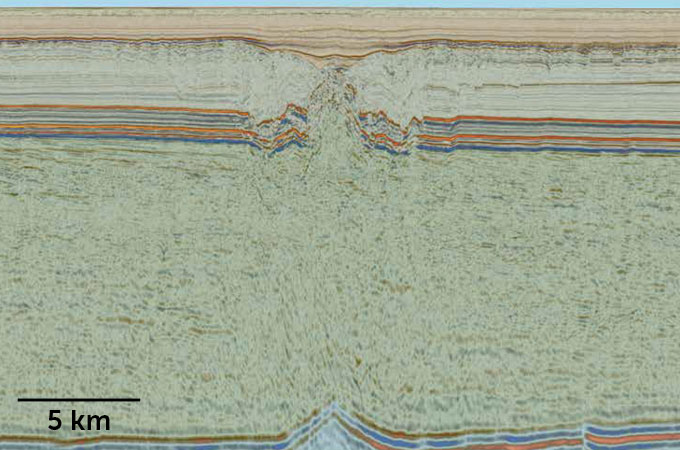Not one, but two asteroids might have ended the age of dinosaurs
The second asteroid’s footprint may be a crater beneath the seafloor near West Africa

Buckled terrain on the seafloor just off the coast of West Africa may have been formed by a 400-meter-long asteroid crashing into the ocean at about the same time as the impact that wiped out the dinosaurs (illustrated).
MARK GARLICK/SCIENCE PHOTO LIBRARY/Getty Images Plus
By Nikk Ogasa
The asteroid that wiped out most dinosaurs might have had a little sibling.
Off the coast of West Africa, scientists think they’ve spotted the remains of a crater 8.5 kilometers (5.3 miles) wide. Named Nadir, this potential crater lies buried hundreds of meters (feet) beneath the seafloor. The team suspects that an asteroid carved out this crater around the time that another space rock slammed into modern-day Mexico. That asteroid, which left the Chicxulub (CHIX-uh-loob) crater, was thought to have created enough havoc to have wiped out all nonbird dinosaurs.
The new crater finding needs to be confirmed. But if it is, that could mean that nonbird dinos met their demise by a one-two punch of asteroids. Researchers shared this finding in the August 17 Science Advances.
“The idea that [Chicxulub] had help — for want of a better phrase — would have really added insult to serious injury,” says Veronica Bray. This planetary scientist works at the University of Arizona in Tucson. She was part of the team that discovered Nadir.
A scar in the seafloor
Around 200 craters left by asteroid impacts have been discovered on Earth. Almost all of them have been found on land. That’s because impact craters at sea gradually become buried under sediment, Bray explains. That makes them much harder to detect. So Nadir is a valuable find, she says, no matter when it formed.
Uisdean Nicholson was the first one to glimpse Nadir. He’s a geologist at Heriot-Watt University in Edinburgh, Scotland. Nicholson was looking at data from seismic waves that researchers had sent underground off the coast of Guinea in West Africa. Studying how those waves rippled through Earth revealed the ocean floor’s terrain.
Lurking beneath the seafloor was a bowl-shaped structure. It had a broken-up floor and a central peak. Both are features expected of a large-impact crater.
If a pockmark of this size was left by an asteroid, that space rock was probably more than 400 meters (1,300 feet) wide, the researchers calculate. What’s more, the impact could have rocked the ground like a magnitude 7 earthquake. The collision would have also stirred tsunamis hundreds of meters (feet) high.

Still, the Nadir impact would have been far less devastating than the one at Chicxulub, says Michael Rampino. He works in New York City. A geologist at New York University, he did not take part in the new study. The asteroid that punched out the Chicxulub crater had been about 10 kilometers (6.2 miles) wide. Its impact kicked enough debris into the atmosphere to encircle the globe and dim the sun. Nadir, on the other hand, “certainly wouldn’t have had global effects,” Rampino says.
The ages of rock above and below Nadir offer clues to when its structure formed. It was probably about 66 million years ago, the researchers say. That’s about the time that the Chicxulub asteroid struck and most dinosaurs went extinct.
The Nadir asteroid may even have formed a pair with the Chicxulub asteroid, the team speculates. The two rocks could have been ripped apart by gravity while zooming past Earth on a previous loop around the sun.
Collecting more evidence
Not everyone is convinced that the structure Bray’s team found is an asteroid footprint.
“It looks like an impact crater. But it could also be something else,” says Philippe Claeys. This geologist at Vrije Universiteit Brussel in Belgium also did not take part in the new study. Confirming Nadir is an impact crater will require drilling for solid evidence, he says. That evidence could be shocked quartz — a mineral forged by asteroid impacts.
If not an impact crater, what is Nadir? Well, there are a few options. It could be a collapsed volcanic caldera, for instance. Or a squeezed body of salt called a salt diapir.
Even if Nadir was made by an asteroid, that doesn’t mean it helped kill off the dinosaurs. The structure’s age is still uncertain. Seismic data suggest it formed around 66 million years ago or maybe a little later, Claeys says. “But that’s around the best they can say.” Drilling in the crater for minerals that contain radioactive elements could provide a more precise date.
Bray and her colleagues now want to collect samples from the crater. They hope to drill in 2024. That may settle some of the debate about Nadir’s origins, Bray says. But new questions will probably arise. “If we do prove that this is the sister of the dinosaur killer,” she says, “then how many other siblings are there?”







